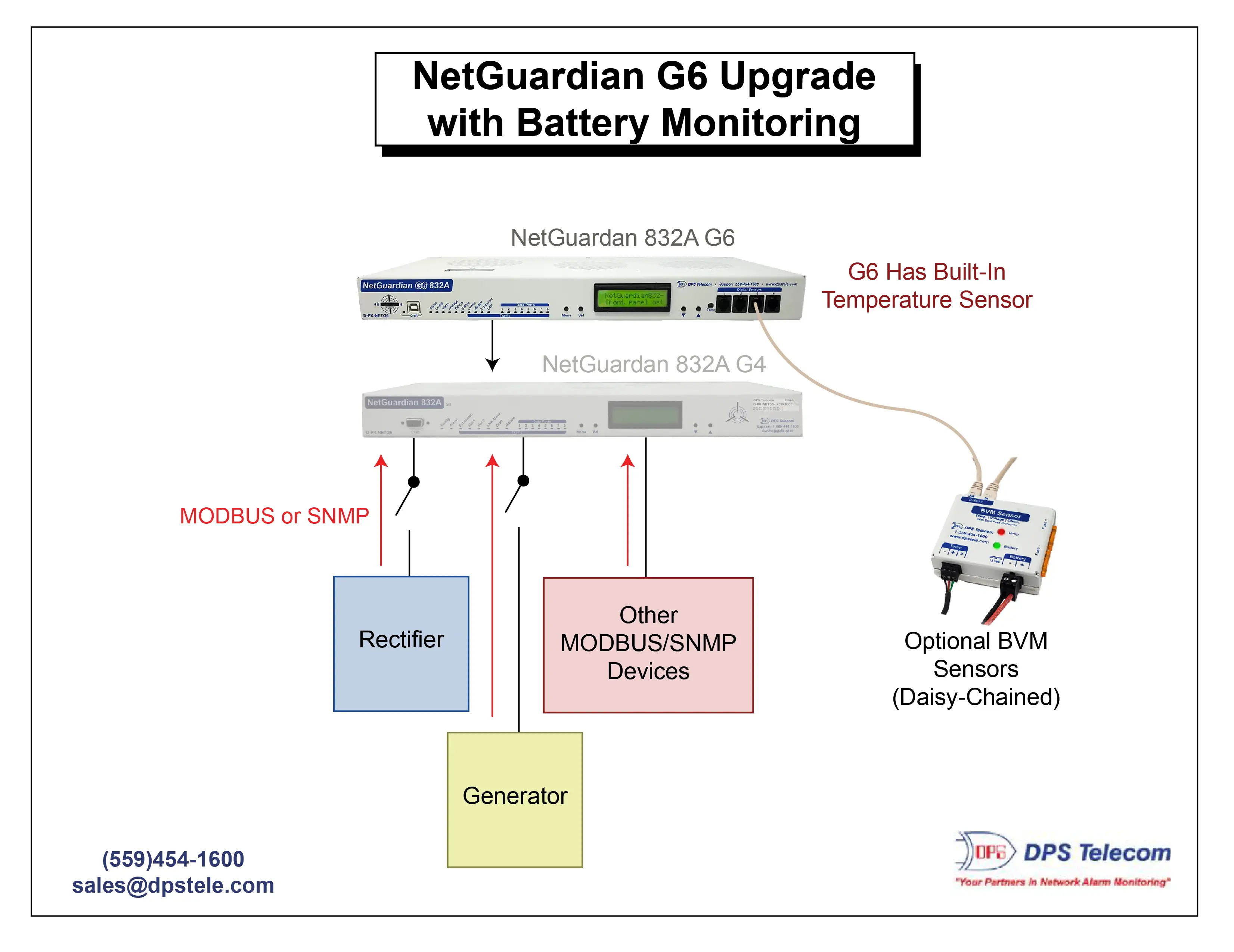Ensure Uptime with Smarter RTUs: Upgrade for Advanced Battery Monitoring
By Andrew Erickson
March 28, 2025
Any remote site with important equipment needs good monitoring. Even so, when it comes to backup power systems - batteries, rectifiers, and generators - you might be overlooking the level of detail needed to properly monitor this equipment.
If any of these devices fail unexpectedly, your company or agency could suffer significant downtime, damaging your reputation, bottom line, and/or public safety. That's why it's so important to keep your monitoring system updated to contemporary standards.
Let's explore why upgrading your RTU to stay up-to-date is the best choice for modern backup-power monitoring, especially UPS battery monitoring.
Unmonitored or Poorly Monitored Batteries Cause Costly Downtime
To best prepare for an emergency, consider everything that can go wrong (with your backup power, in this case). Batteries degrade over time, and a single weak cell can jeopardize your entire power backup system.
If your site UPS batteries fail when the power grid goes down, that can mean:
- Unexpected battery failures - A single bad battery can take down your entire backup system.
- Overheating and degraded performance - Heat is a primary cause of battery failure.
- High maintenance costs - Reactive maintenance (replacing entire battery banks) is much more expensive than proactive monitoring.
- Service disruptions - Network downtime leads to dissatisfied customers, SLA penalties, and bad PR/press.
Without real-time visibility into battery health, you're "flying blind". Manual inspections are infrequent and needlessly expensive.
Less sophisticated monitoring systems often rely on generic alarms that trigger only when a complete battery bank fails (or its voltage falls out of a normal range). At that point, it can be too late to prevent an outage.
What Specific Features are you Missing with Older RTUs?
If you're still relying on older RTUs in a "legacy" monitoring setup, you might be missing important features, such as:
- Built-In Temperature Sensors - Heat has a big impact on battery lifespan.
- MODBUS/SNMP Support - You need end-to-end visibility of all power sources.
- Real-Time Battery Voltage Monitoring - Without granular data, you can't detect early battery degradation.
Not having these features can lead to delayed response times and higher maintenance costs. Ultimately, you'll be left scrambling when a battery failure occurs.
Get Comprehensive, Real-Time Battery Monitoring
You need a system that provides continuous visibility into the health of every battery. You'll also want strong integration with rectifiers, generators, and other power equipment. This means:
- Monitoring individual battery voltage levels
- Detecting early signs of battery degradation
- Integrating cleanly with rectifiers and generators
- Using SNMP and MODBUS protocols for remote monitoring
Find the Best RTU for Power and Battery Monitoring
The NetGuardian 832A G6 is an example of an RTU that provides real-time monitoring for your batteries and other devices. Despite its similar appearance and pin-compatible ports, this NetGuardian isn't just an incremental upgrade from older models like the NetGuardian 832A G4 or G5. You gain several new abilities.
Key Features of the NetGuardian 832A G6
- Built-In Temperature Sensor
Overheating is a major threat to battery health. The G6 offers a built-in temperature sensor to catch overheating batteries before they fail. This eliminates the need for separate external probes (although that is also supported via D-Wire). - MODBUS and SNMP Integration
The G6 supports both MODBUS and SNMP, allowing you to monitor devices locally. This allows you RTU to make local if-then decisions as needed and aggregates alarms into a single stream for you. MODBUS and SNMP are common outputs from: - Rectifiers - Keep track of power conversion performance.
- Generators - Make sure your backup generators are ready to kick in when needed.
- "Smart" Battery Banks - Get individual battery stats from many industry-standard battery
- Any other "MODBUS" or "SNMP" Devices - Enjoy a "single-pane-of-glass" view of all your power infrastructure.
- Supports Battery Voltage Monitoring (BVM) Sensors
Traditional RTUs often only monitor an entire battery bank's voltage. If one battery is failing, you might not know until it takes down your whole system. The G6's optional BVM sensors track individual battery voltages. With these daisy-chained sensors, you can: - Detect weak batteries early.
- Replace only faulty batteries, cutting maintenance costs.
- Keep your backup power system in peak condition, ensuring maximum uptime.
- Remote Alarm and Notification Capabilities
The G6 immediately sends alarms via SNMP or MODBUS to your NOC or on-call personnel when problems appear. If a battery starts failing, you'll get a real-time alert. This enables you to: - Take action quickly before a blackout hits.
- Schedule maintenance proactively rather than reacting to emergencies.
- Minimize downtime and protect your reputation.
Benefits of Upgrading to the NetGuardian 832A G6
- Improved Network Reliability
- Prevent power failures with real-time monitoring.
- Be sure your backup batteries and generators are always ready.
- Detect early warning signs of battery degradation or overheating.
- Reduced Maintenance Costs
- Avoid replacing entire battery banks by targeting only the failing units.
- Cut labor costs by eliminating manual inspections.
- Lower the risk of expensive emergency repairs.
- Remote Monitoring and Scalability
- View live power data from anywhere via SNMP/MODBUS.
- Integrate with existing NOC dashboards and software.
- Expand your monitoring setup with ease by adding more D-Wire sensors, including BVM battery sensors.
- Prepare Your Infrastructure for the Future
- Migrate easily from G4 to G6 without overhauling your entire network.
- Add capabilities over time instead of doing a big one-time hardware replacement.
- Stay prepared for tomorrow's challenges with a truly dependable RTU.
NetGuardians Excel Across Many Different Industries
The NetGuardian 832A G6 isn't just a solution for telco companies. It's used across multiple industries where power reliability is required at any kind of remote facility, including:
Telecom Networks
- The NetGuardian 832A G6 keeps cell towers and remote switching stations powered during grid failures.
- The G6 NetGuardian reduces truck rolls by enabling remote battery diagnostics - technicians only visit when they truly need to.
Power Utilities
- The device monitors substation batteries that support critical utility telecom operations.
- It prevents blackouts by identifying weak power backups before they fail.
Transportation & Railways
- This NetGuardian supports remote signaling stations and control systems.
- The RTU sends real-time alerts to operations centers if backup power is compromised.
Data Centers & IT Facilities
- G6 NetGuardians protect server uptime by monitoring UPS (Uninterruptible Power Supply) batteries.
- They integrate smoothly with existing network management software, giving you a single dashboard for all power tracking.
Any Industry That Has Remote Assets to be Monitored Remotely
No matter what industry, the NetGuardian 832A G6 helps make sure backup power remains reliable, maintenance costs are minimized, and unexpected failures are avoided.
There are Hidden Costs of Unmonitored Batteries
Many organizations underestimate the true cost of poor battery monitoring. A power failure is more than just an inconvenience. It can have severe financial and operational impacts.
Unplanned Downtime Costs
- Telecom Networks: A single hour of downtime can cost thousands in SLA penalties and lost customers.
- Data Centers: According to Uptime Institute studies, over half of the respondents to the 2023 data center survey said their most recent serious outage costs exceeded $100,000 (Uptime Institute).
Increased Maintenance Expenses
- Manual Inspections: Relying on technicians to perform battery checks drives up labor costs.
- Unnecessary Full Battery Bank Replacements: Without granular monitoring, you replace everything instead of just what's actually failing.
Reputation Damage
- Customer Expectations: 99.99% uptime is the norm. Frequent outages will push your customers toward competitors.
- Regulatory Fines: In critical industries (like utilities), you might face penalties if essential services fail.
When you consider the entire cost, unmonitored batteries can be a big hit to your bottom line. Solve this with real-time battery monitoring. It will provide a straightforward way to avoid these costs, keep customers happy, and maintain a strong reputation.
How the NetGuardian 832A G6 Compares to Competitors
Choosing the right battery monitoring solution means comparing features across different options. Here's a quick example of a NetGuardians vs. two example competing devices:
| Feature | NetGuardian 832A G6 | Competitor A | Competitor B |
| Built-in temperature monitoring | Yes | No | No |
| Supports MODBUS & SNMP | Yes | Yes | No |
| Optional BVM Sensors for per-battery monitoring | Yes | No | Yes |
| Daisy-chained sensor expansion | Yes | No | No |
| Remote access and alarming | Yes | Yes | Yes |
| Designed for telecom, power utilities, and IT | Yes | No | Yes |
Why the NetGuardian 832A G6 Wins
- More Comprehensive Monitoring - A built-in temperature sensor means no hassle with external probes.
- Scalability - Daisy-chained BVM sensors let you expand without cable mess from home-running wiring.
- Industry-Grade Reliability - Built to handle harsh environments where other solutions struggle.
Best Practices for Optimizing Your Battery Monitoring Strategy
To ensure maximum uptime and extended battery life, follow these tips when implementing a NetGuardian 832A G6 or other up-to-date RTU.
Deploy Battery Voltage Monitoring (BVM) Sensors
- Monitor individual battery voltage - not just the full bank.
- Identify failing batteries early to prevent major power failures.
Set Up Automated Alerts for Early Warnings
- Configure SNMP traps or email notifications for low voltage, high temperature, or power loss events.
- Route alarms to your NOC for immediate response.
Integrate with Existing Monitoring Systems
- Use MODBUS and SNMP support for smooth integration with SCADA or network management software.
- Combine power data into one dashboard for better visibility.
Schedule Regular Firmware Updates & System Checks
- Keep your RTU current with the latest firmware for new features and security patches.
- Review power logs quarterly to spot trends, reduce risks, and optimize maintenance schedules.
Get a Budgetary Upgrade Quote Early
Whether you run a telecom network, a substation, a rail system, or a data center, the stakes are high. Power disruptions don't just cause inconvenience; they can cost you in downtime fees, lost customer trust, and even regulatory fines.
Don't wait for the next power failure to realize your monitoring system isn't detailed enough to give you good alerts. Begin work on your upgrade now to be sure your network stays online, your batteries stay healthy, and your maintenance costs stay low.
Call: (559) 454-1600
Email: sales@dpstele.com
We'll walk you through real examples from past DPS projects and help you design a setup that meets your exact needs.

Andrew Erickson
Andrew Erickson is an Application Engineer at DPS Telecom, a manufacturer of semi-custom remote alarm monitoring systems based in Fresno, California. Andrew brings more than 18 years of experience building site monitoring solutions, developing intuitive user interfaces and documentation, and opt...


